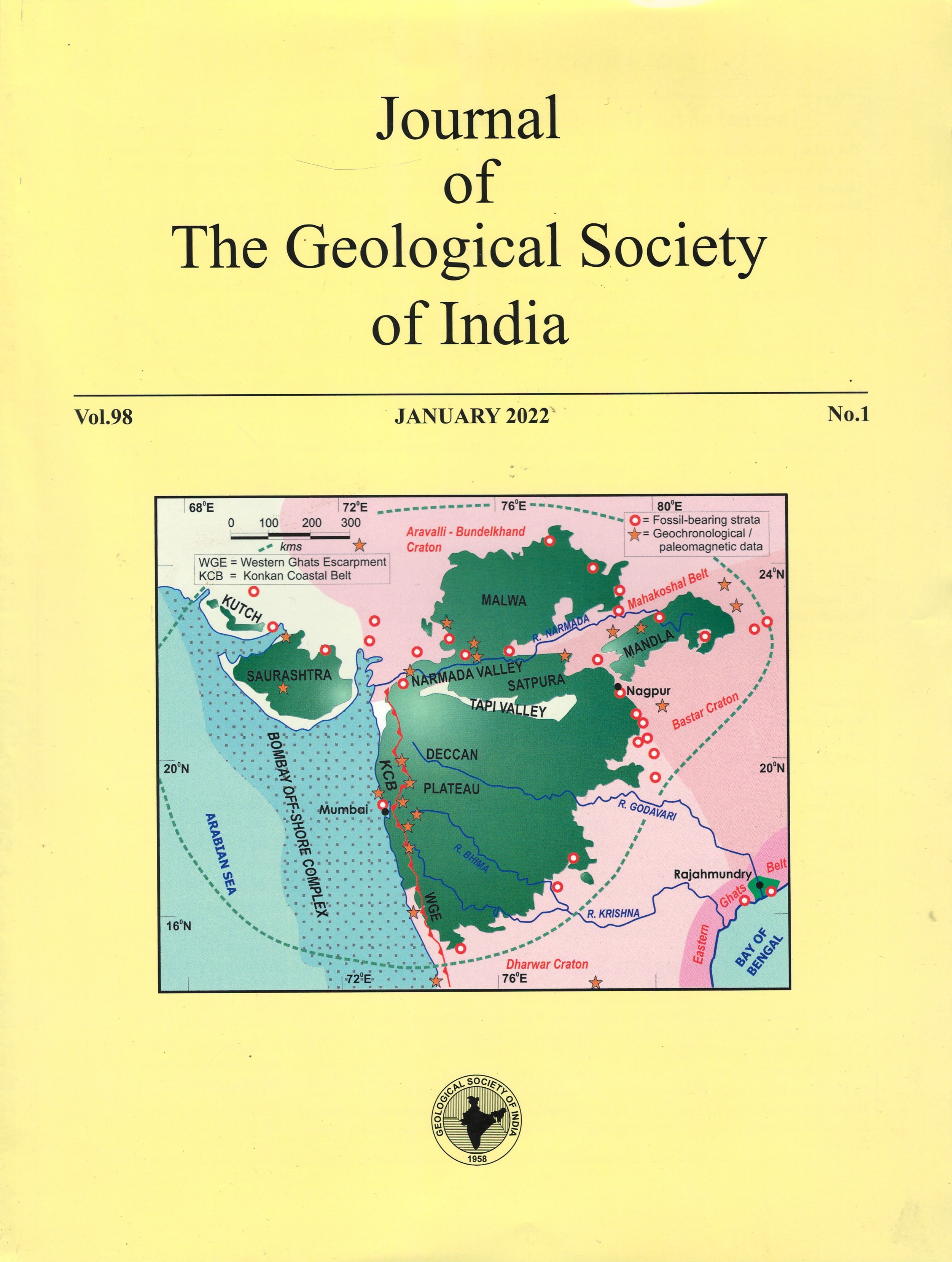Occurrence of Gold in the Mesoarchean Mayurbhanj Gabbros of Singhbhum Craton, Eastern India
DOI:
https://doi.org/10.1007/s12594-022-1927-zKeywords:
No KeywordsAbstract
Singhbhum craton of eastern India is bestowed with several metal deposits such as iron, manganese, chromite, and platinum group of elements (PGE). Iron and manganese ores are associated with banded iron formations of Paleoarchean greenstone belts, and chromite and PGEs are associated with mafic-ultramafic rocks of Mesoarchean Baula- Nuasahi and Sukinda belts. Earlier studies indicate a hydrothermal origin of PGE mineralisation. Here, the occurrence of micron-sized gold grain and base metal sulfides in the Mesoarchean Mayurbhanj Gabrro Anorthosite Complex (GAC) are reported. These gabbros are considered coeval with Mayurbhanj granites and comprise of plagioclase, clinopyroxene and orthopyroxene, amphiboles, minor quartz, chlorite, and accessory opaque mineral phases. Scanning Electron Microscopic study shows the occurrence of a ∼3 µm sized sub-rounded gold spherule in feldspar, along with disseminated grains of sulphides of varying sizes. Geochemical analysis reveals that the Sarat-Ghat exposure of Mayurbhanj GAC contains an appreciable amount of gold and PGE (∑PGEs up to 1094 ppb and Au up to 396.5 ppb). The presence of sulphide minerals and intense alteration of feldspars and pyroxenes in the mineralised zone points towards a hydrothermal origin. This lithounit warrants a detailed appraisal to understand the nature and extent of gold and PGE mineralisation.
Downloads
Metrics
Issue
Section
Downloads
Published
How to Cite
References
Augé, T., Cocherie, A., Genna, A., Armstrong, R., Guerrot, C., Mukherjee, M.M. and Patra, R.N. (2003) Age of the Baula PGE mineralisation (Orissa, India) and its implications concerning the Singhbhum Archaean nucleus. Precambrian Res., v.121, pp.85–101. doi:10.1016/S0301- 9268(02)00202-4
Baidya, T.K., Mondal, S.K., Balaram, V., Parthasarathy, R., Verma, R. and Mathur, P.K. (1999) PGE-Ag-Au mineralisation in a Cu-Fe-Ni sulphiderich breccia zone of the Precambrian Nuasahi ultramafic-mafic complex, Orissa, India. Jour. Geol. Soc. India, v.54, pp.473–482.
Chakraborti, T.M., Kimura, K., Ray, A., Kumar Deb, G. and Chakrabarti, R. (2021) Geochemical, Sr-Nd isotopic and U-Pb zircon study of 1.88 Ga gabbro-wehrlite from north-eastern Singhbhum Craton, India: Vestiges of Precambrian oceanic crust? Precambrian Res., v.362, 106302. doi:10.1016/j.precamres.2021.106302
Chaudhuri, T. (2020) A review of Hadean to Neoarchean crust generation in the Singhbhum Craton, India and possible connection with Pilbara Craton, Australia: The geochronological perspective. Earth-Sci. Rev. v.202, 103085. doi:10.1016/j.earscirev.2020.103085
Jafri, S.S.H., Dwivedi, S.K., Pandey, O.P., Tripathi, P., Sarma, D.S., Krishna, A.K., Ramesh, S.L. and Vidyasagar, G. (2021) Possible occurrence of Palaeoarchean ferropicrite cumulates and ferrobasalts in the Jojohatu area of North Singhbhum Craton, eastern India: Evidence for a mantle plume source. Geol. Jour., v.56, pp.5839– 5862. doi:10.1002/gj.4278
Kumar, A., Parashuramulu, V., Shankar, R. and Besse, J. (2017) Evidence for a Neoarchean LIP in the Singhbhum craton, eastern India: Implications to Vaalbara supercontinent. Precambrian Res., v.292, pp.163–174. doi:10.1016/j.precamres.2017.01.018
Manikyamba, C., Pahari, A., Santosh, M., Ray, J., Sindhuja, C.S., Subramanyam, KSV and Singh, M.R. (2020) Mesoarchean gabbroanorthosite complex from Singhbhum Craton, India. Lithos, v.366–367, 105541. doi:10.1016/j.lithos.2020.105541
Misra, S., Sarkar, S.S. and Ghosh, S. (2002) Evolution of Mayurbhanj Granite Pluton, eastern Singhbhum, India: A case study of petrogenesis of an Atype granite in bimodal association. Jour. Asian Earth Sci. v.20, pp.965– 989. doi:10.1016/S1367-9120(02)00002-0
Mondal, S.K. and Baidya, T.K. (1997) Platinum-group minerals from the Nuasahi ultramafic-mafic complex, Orissa, India. Mineral. Mag. v.61, pp.902–906. doi:10.1180/minmag.1997.061.409.13
Rao, N.V.C., Ram, M., Sutaone, A.T. and Gundewar, C.S. (2006) Gold in Chromite Ore of South Kaliapani Mines, Sukinda Ultramafic Belt, Jajpur District, Orissa. Jour. Geol. Soc. India v.68, pp.171–175.
Rasheed, K., Sarma, D.S., Asokan, A.D., Dash, J.K. and Bhutani R. (2021) A non-arc tectonic setting for the evolution of Archean gabbro anorthosite Complexes: Evidence from the Singhbhum Craton, eastern India. Precambrian Res., 106250. doi:10.1016/j.precamres.2021.
Robb, L. (2020) Introduction to ore-forming processes. John Wiley & Sons. v.1, pp.1-373
Saha, A.K. (1994) Crustal Evolution of Singhbhum North Orissa Eastern India. Mem. Geol. Soc. India, no..27, pp.1-341
Sahoo, P.R. and Venkatesh, A.S. (2015) Constraints of mineralogical characterisation of gold ore: Implication for genesis, controls and evolution of gold from Kundarkocha gold deposit, eastern India. Jour. Asian Earth Sci., v.97, pp.136–149. doi:10.1016/j.jseaes.2014.09.040
Satyanarayanan, M., Balaram, V., Sawant, S.S., Subramanyam, K.S.V., Krishna, G.V., Dasaram, B. and Manikyamba, C. (2018) Rapid determination of REEs, PGEs, and other trace elements in geological and environmental materials by high resolution inductively coupled plasma mass spectrometry. Atomic Spectroscopy, v.39(1), pp.1–15.
Shankar, R., Vijaya Gopal, B. and Kumar, A. (2014) Precise Pb-Pb baddeleyite ages of 1765 ma for a Singhbhum “newer dolerite” dyke swarm. Curr. Sci., v.106, pp.1306–1310.
Shankar, R., Sarma, D.S., Babu, N.R. and Parashuramulu, V. (2018) Paleomagnetic study of 1765 Ma dyke swarm from the Singhbhum Craton: Implications to the paleogeography of India. Jour. Asian Earth Sci., v.157, pp.235-244.

 K. Rasheed
K. Rasheed






